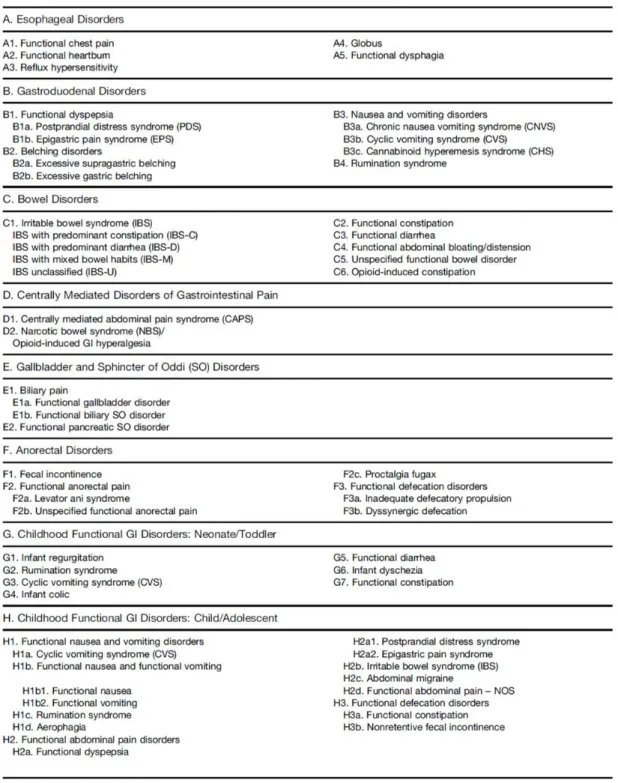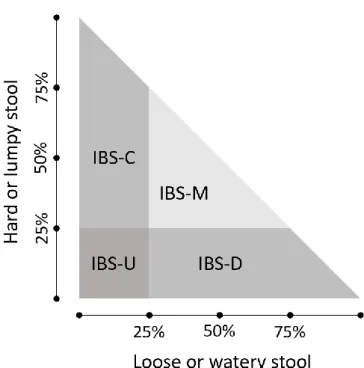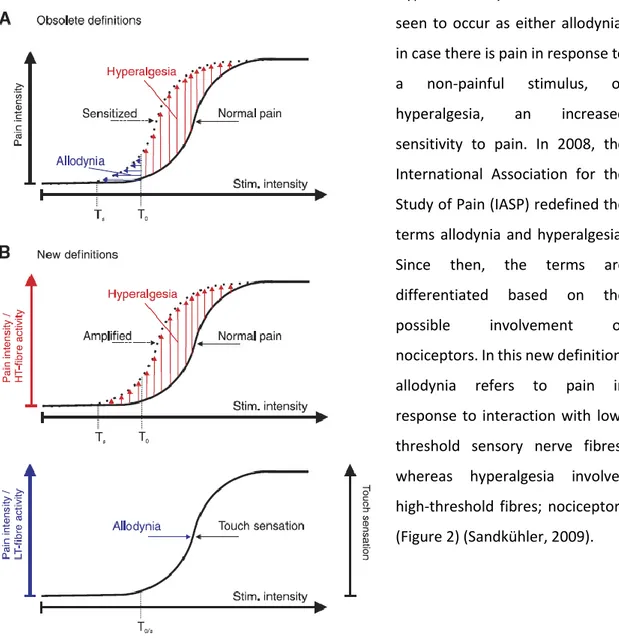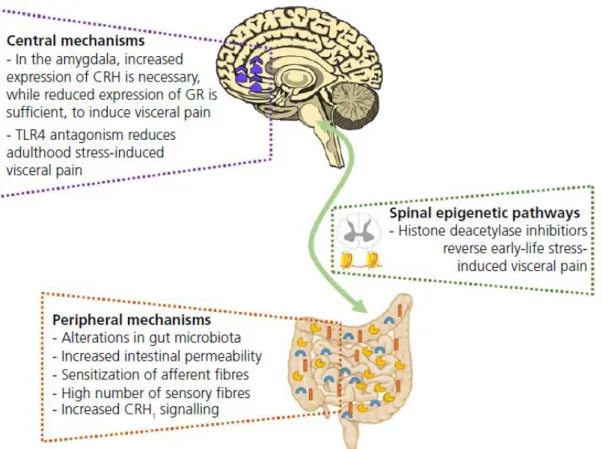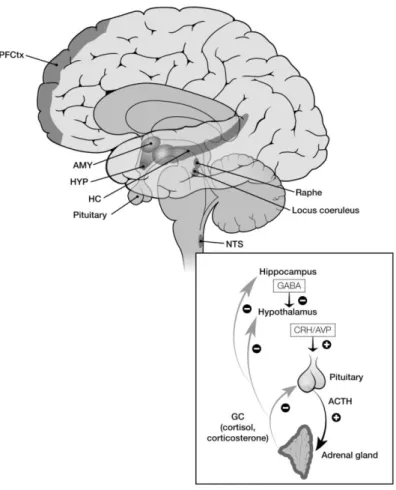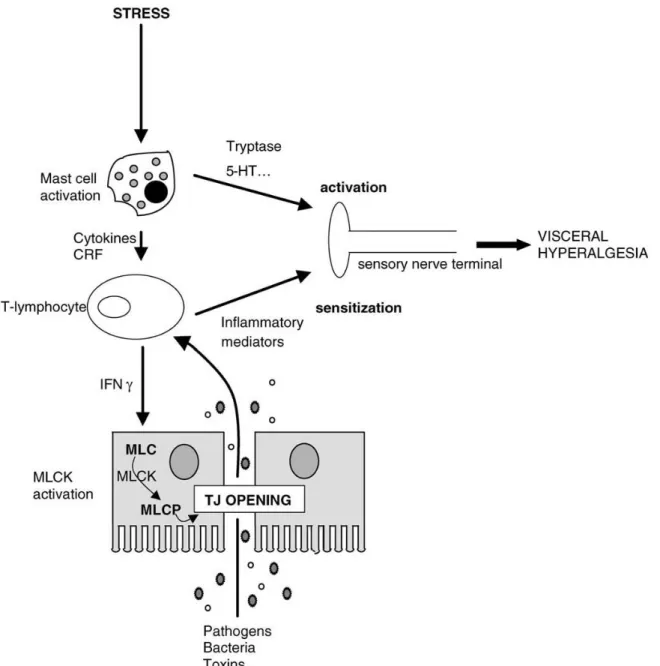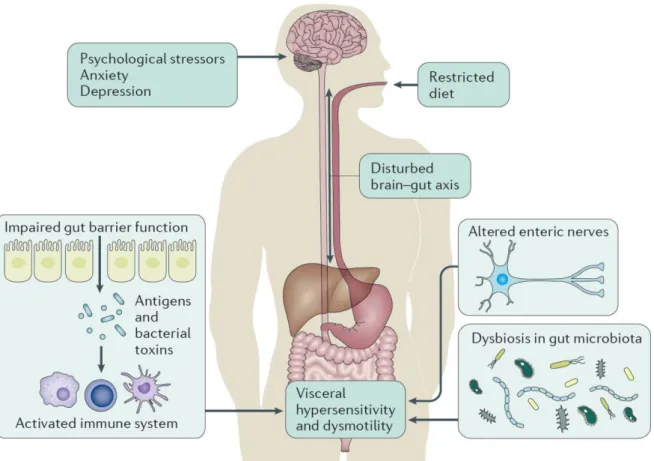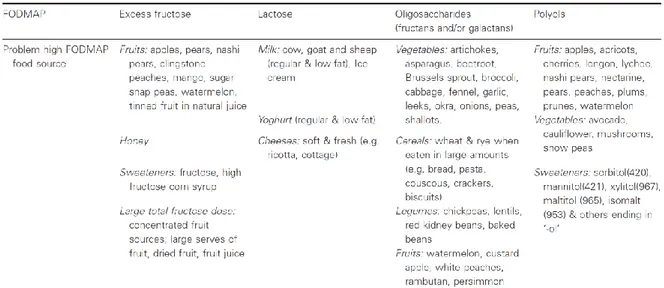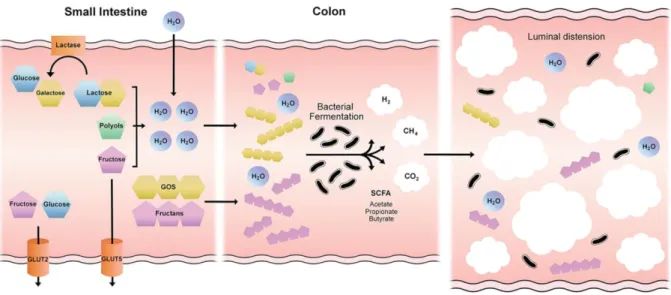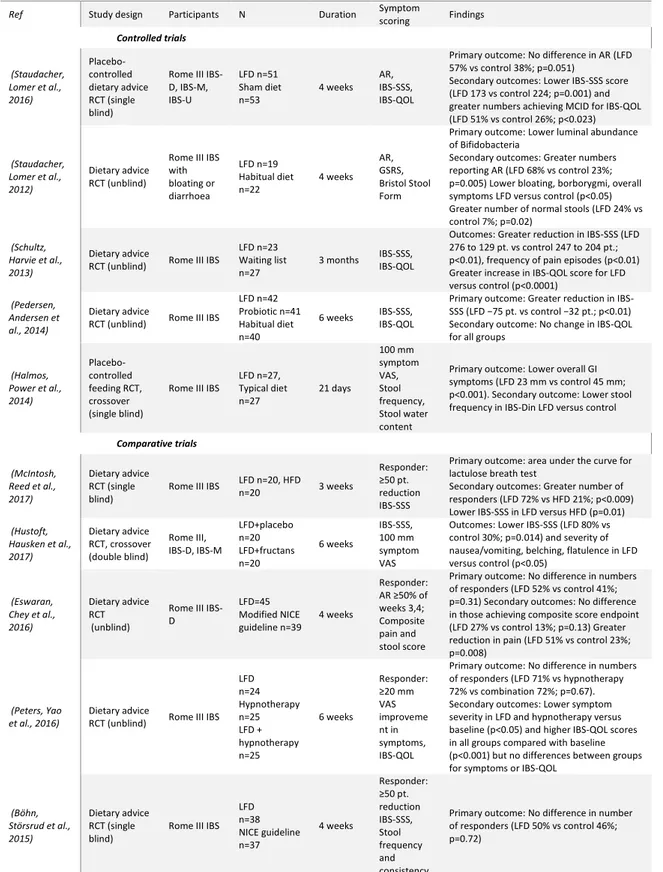En vue de l'obtention du
DOCTORAT DE L'UNIVERSITÉ DE TOULOUSE
Délivré par :
Institut National Polytechnique de Toulouse (Toulouse INP) Discipline ou spécialité :
Pathologie, Toxicologie, Génétique et Nutrition
Présentée et soutenue par :
M. JASPER KAMPHUIS le vendredi 4 octobre 2019
Titre :
Unité de recherche : Ecole doctorale :
Increased intake of fermentable carbohydrates induces IBS-like symptoms;
a complementary understanding of mechanisms involved
Sciences Ecologiques, Vétérinaires, Agronomiques et Bioingénieries (SEVAB) Toxicologie Alimentaire (ToxAlim)
Directeur(s) de Thèse : MME HÉLÈNE EUTAMENE MME VASSILIA THEODOROU
Rapporteurs :
M. BRUNO BONAZ, CHU GRENOBLE
M. JAVIER SANTOS VICENTE, VALL D'HEBRON UNIVERSITY HOSPITAL Membre(s) du jury :
Mme CATHERINE MULLER, UNIVERSITE TOULOUSE 3, Président Mme HÉLÈNE EUTAMENE, EI PURPAN, Membre
Mme INGRID RENES, NUTRICIA RESEARCH UTRECHT, Membre Mme VASSILIA THEODOROU, EI PURPAN, Membre
Increased intake of fermentable
carbohydrates induces IBS-like symptoms;
a complementary understanding of
mechanisms involved
Visceral sensitivity, intestinal barrier function,
bacterial metabolites, and organisation of mucus secretions
Peering into a microscope in the dark invites the mind to make new friends, some of which are displayed on the Chapter pages of this dissertation; the “Faces in Faeces”.
“....By this the Earth it self, which lyes so near us, under our feet, shews quite a new thing to us, and in every little particle of its matter, we now behold almost as great a variety of Creatures, as we were able before to reckon up in the Whole Universe it self....”
~Robert Hooke in Micrographia, 1665
“A’j’t oaweral met eens bint, bi’j rap oetkek’n” *
To my parents, who have supported me throughout 30 years of learning
To my friends, who are my friends
* “Als je het overal met eens bent, ben je snel uitgekeken” * “If you’d agree with everything, you would soon cease to wonder” * ” Si vous étiez d’accord avec tout, vous ne vous poseriez plus de questions “
Table of Contents
Summary ... 1
Résumé ... 2
Abbreviations ... 3
1 General Introduction ... 9
1.1 A fresh look at IBS – opportunities for systems medicine approaches ... 10
1.2 IBS, FODMAPs ... 15
1.2.1 Functional gastrointestinal disorders (FGIDs) ... 15
1.2.2 Aetiology IBS and physiopathology ... 21
1.2.3 Clinical practice ... 38
1.2.4 FODMAP diet ... 43
1.3 Intestinal microbiota ... 49
1.3.1 Function ... 49
1.3.2 Toxic metabolite hypothesis ... 56
1.4 Bacterial Metabolites; aldehydes/ methylglyoxal ... 57
1.4.1 Chemical properties of methylglyoxal ... 57
1.4.2 Biological properties of methylglyoxal ... 58
1.4.3 Deleterious effects of dicarbonyl stress ... 60
1.4.4 Detoxification – glyoxalase system ... 62
1.5 Intestinal barrier function ... 67
1.5.1 Epithelial barrier ... 67
1.5.2 Permeability ... 71
1.5.3 Mucus barrier ... 73
1.6 Aims and Outline of Thesis ... 83
1.6.1 Hypotheses ... 83
1.6.2 Approach ... 85
2 Project Results ... 97
2.1 Mucus organisation is shaped by colonic content; a new view ... 97
2.2 FODMAPs increase visceral sensitivity in mice through glycation processes, increasing mast cell counts in colonic mucosae ... 111
2.3 Increased FODMAP intake alters colonic mucus barrier function through glycation processes and increased mastocyte counts ... 151
3 General Discussion ... 171
3.1 Fermentable carbohydrates and IBS symptoms ... 172
3.2 Immune activation ... 176
3.3 Permeability ... 177
3.4 Role of glycation in efficacy of low-FODMAP diet ... 178
3.5 Mucus barrier ... 181
3.6 Concluding remarks ... 184
4 Acknowledgments ... 189
5 Publications, Dissemination and Training Activities ... 195
5.1 Publications part of this thesis ... 195
5.2 Other Publications ... 195
5.3 Oral presentations ... 196
5.4 Poster presentations ... 197
5.5 Other training and dissemination activities ... 199 6 References ... I
P a g e | 1
Summary
Irritable bowel syndrome (IBS) is a functional gastrointestinal disorder (FGID) characterized by abdominal pain, bloating, and erratic bowel habits. It is an affliction with a high prevalence of around 11% worldwide. It carries a significant economic cost in lost productivity and work absence, and more importantly, it has a strong negative impact on quality of life. Because it is a functional disorder of which the causes are not well understood, treatment is difficult. In recent years, a low-FODMAP diet (low in Fermentable Oligo-, Di-, Mono-saccharides And Polyols) has been successfully used to reduce symptoms of IBS. The efficacity of this approach is not completely understood, but a reduction in enteric distension by reduced gas production and small intestinal water bulk by osmotic effects are most often cited. The bacterial metabolic toxin hypothesis, proposed by Campbell et al. poses that anaerobic fermentation of unabsorbed carbohydrates by the colonic gut microbiota, producing such metabolites as alcohols, ketones, and aldehydes, are responsible for food intolerances such as lactose intolerance. We hypothesized that this same mechanism could be extended to FODMAPs to explain the efficacity of the low-FODMAP diet.
In this thesis, we looked for complementary mechanisms on how FODMAPs could influence IBS symptoms, besides distension related complaints. Our studies in a healthy mouse model show a complex role for FODMAPs in IBS physiopathology; FODMAP treatments cause a visceral and abdominal hypersensitivity, and a mucus barrier dysregulation, characterized using an innovative approach.
We hypothesized that this is due to generation of glycating agents by the intestinal microbiota, and the prevention of these effects by co-treatment with pyridoxamine indicates that this hypothesis is correct. Mucosal mast cell counts were increased in FODMAP treated animals, but not in animals co-treated with pyridoxamine. Mast cells are implicated in visceral hypersensitivity, as well as in mucus barrier dysregulation, and increased mucosal mast cell numbers or activity are often linked to IBS.
This work thus offers a link between the efficacity of the low-FODMAP diet and the involvement of intestinal mast cells in IBS.
2 | P a g e
Résumé
Le syndrome de l’intestin irritable (SII) est un trouble gastro-intestinal fonctionnel caractérisé par des douleurs abdominales, des ballonnements et des troubles du transit intestinal. Cette pathologie digestive a une prévalence mondiale importante d'environ 11%. Elle entraîne un coût économique important : perte de productivité et absentéisme au travail. De plus, elle entraine une forte dégradation de la qualité de la vie des patients. Les causes de ce trouble fonctionnel ne sont pas bien comprises rendant le traitement thérapeutique difficile. Au cours des dernières années, un régime alimentaire à faible teneur en FODMAPs (Fermentable Oligo-, Di-, Mono-saccharides And Polyols) s’est révélé efficace dans la réduction des symptômes du SII. Sur le plan mécanistique ces effets positifs restent à élucider. Toutefois, on cite le plus souvent une réduction de la distension entérique due à une réduction de la production de gaz et du volume d’eau intestinale par des effets osmotiques. Campbell et al. pose l’hypothèse qu’une fermentation anaérobie de carbohydrates non-absorbés par le microbiote intestinal provoque la formation endoluminale de métabolites tels que les alcools, les cétones et les aldéhydes, responsables d'intolérances alimentaires comme l'intolérance au lactose. Nous avons émis l’hypothèse que ce mécanisme pourrait être étendu aux FODMAPs pour expliquer l’efficacité du régime alimentaire pauvre en FODMAPs chez les patients SII.
Nos études montrent un rôle complexe des FODMAPs sur des modèles murins qui reflètent la physiopathologie du SII. Les traitements par FODMAPs (lactose et fructo-oligosaccharides) provoquent une hypersensibilité viscérale et abdominale et une dysfonction de la barrière de mucus au niveau de la muqueuse intestinale.
Nous avons démontré que ces effets étaient dûs à la production d’agents de glycation par le microbiote intestinal. En effet, ces effets étaient prévenus par un co-traitement à la pyridoxamine. Le nombre de mastocytes muqueux était également augmenté chez les animaux traités par FODMAPs et significativement réduit par un co-traitement à la pyridoxamine. Les mastocytes sont connus pour être impliqués dans l’hypersensibilité viscérale et dans la dysrégulation de la barrière de mucus de l’intestin. Par ailleurs, une augmentation du nombre et/ou de l'activité des mastocytes est retrouvée sur des biopsie de patients SII.
Ce travail de thèse original permet donc de faire un lien entre l'efficacité du régime alimentaire à faible teneur en FODMAPs, la symptomatologie et l'implication des mastocytes intestinaux chez le patient SII.
P a g e | 3
Abbreviations
4-HNE 4-hydroxynonenal
ACTH Adrenocorticotropic hormone
AGEs Advanced glycation end products
ANS Autonomous nervous system
APC Antigen-presenting cell
CFAP Chronic Functional Abdominal Pain
cfu colony forming units
cGMP Cyclic guanosine monophosphate
CGRP receptor Calcitonin gene-related peptide
CNS Central nervous system
CRF Corticotropin releasing factor
DAMP Damage-associated molecular pattern
DC Dendritic cell
DSCG Disodium cromoglycate
DSS Dextran sodium sulphate
EMG Electromyographic
ENS Enteric nervous system
FAE Follicle-associated epithelium
FGIDs Functional gastrointestinal disorders
FISH Fluorescent in situ hybridisation
FITC Fluorescein isothiocyanate
FODMAP Fermentable Oligo-, Di-, Mono-saccharides and Polyols
FOS Fructo-oligosaccharides
GABA γ-aminobutyric acid
GALT Gut-associated lymphoid tissue
GAP Goblet cell-associated antigen passages
GC Goblet cell GI Gastrointestinal Glo Glyoxalase GOS Galacto-oligosaccharides GR Glucocorticoid receptors GSH Glutathione
4 | P a g e
HPA-axis Hypothalamic-pituitary-adrenal axis
IBD Inflammatory Bowel Disease
IBS Irritable Bowel Syndrome
IEC Intestinal epithelial cells
Ig Immunoglobulin
IL Interleukin
LAB Lactic acid bacteria
LFD Low-FODMAP diet
LPS Lipopolysaccharide
M cell Microfold cell
MAMP Microbe-associated molecular pattern
MAPK Mitogen-activated protein kinase
MDA Malonaldehyde
MG Methylglyoxal
MGS Methylglyoxal synthase
MLCK Myosin Light Chain Kinase
MR Mineralocorticoid receptors
NF-κB Nuclear factor kappa-light-chain-enhancer of activated B cells
NGF Nerve growth factor
NLRP6 Nod-like receptor family pyrin domain containing 6
OR Odds ratio
PAR-2 Protease-activated receptor 2
PI-IBS Post-infectious Irritable Bowel Syndrome
PM Pyridoxamine
PRR Pattern recognition receptor
PRS Partial restraint stress
QOL Quality of Life
RAGE Receptor for advanced glycation end products
RCT Randomized controlled trial
ROS Reactive oxygen species
SAM Sympathetic adrenomedullary system
SCFA Short-chain fatty acid
P a g e | 5
SIBO Small intestinal bacterial overgrowth
SP Substance P
TGFβ Transforming growth factor beta
TJ Tight junction
TLR Toll-like receptor
TNBS 2,4,6-trinitrobenzene sulfonic acid
TNF-α Tumour Necrosis Factor α
Tregs Regulatory T-cells
UC Ulcerative Colitis
UWL Unstirred water layer
WAS Water avoidance stress
WHO World Health Organization
1 General Introduction
P a g e | 9
1 General Introduction
This thesis project was part of the Initial Training Network (ITN) NeuroGUT, financed by the People Programme of the European Union’s Seventh Framework Programme. This training network aimed to offer training in neurogastroenterology and complementary skills to young researchers, to help form the next generation of scientists dedicated to the rapidly developing field of neurogastroenterology. The projects financed in this way all pertain to functional gastrointestinal disorders (FGIDs) and investigate such topics as the involvement of gut-brain interaction, nutritional challenges of the immune system, low-grade inflammation, and post-infectious changes to the enteric nervous system as possible pathophysiological mechanisms. The network contains both clinical and basic science partners, and fellows with both medical and research science backgrounds were recruited. During the project, fellows met several times per year for training activities and annual meetings, as well as for scientific conferences. One such training activities was a Summer School organised around the Bologna IBS Days 2016, and the results of training activities during this summer school were published as a Position Paper in the Neurogastroenterology and Motility journal (Albusoda, Barki et al., 2017), which is included as the first section after this general introduction.
The goal of this thesis project was to investigate and describe mechanisms by which FODMAPs (Fermentable Oligo-, Di-, Mono-saccharides and Polyols) can induce symptoms of Irritable Bowel Syndrome (IBS), based on the facts that a low-FODMAP diet can successfully reduce symptoms in IBS patients (Gibson and Shepherd, 2005; Halmos, Power et al., 2014; Böhn, Störsrud et al., 2015; Marum, Moreira et al., 2016a; Prince, Myers et al., 2016; McIntosh, Reed et al., 2017), and that fermentation of certain non-absorbable carbohydrates can lead to the formation of methylglyoxal, with negative local and systemic effects (Campbell, Waud et al., 2005; Campbell, Matthews et al., 2010). We hypothesized that FODMAP fermentation could have sensitizing and immuno-modulatory effects in the colon by production of toxic microbial metabolites, which supplements the prevailing idea that the efficacity of the low-FODMAP diet is related to the increased intestinal distension via osmotic effects and gas production (Barrett, Gearry et al., 2010; Ong, Mitchell et al., 2010) induced by FODMAP intake, in an already hypersensitive system. To get more insight into this matter and test our hypothesis, we used an animal model to measure relevant markers in colonic tissues and digesta, such as mastocyte counts, mucus barrier function, and aldehyde contents of faeces, as well as more systemic parameters, such as visceral and abdominal sensitivity.
10 | P a g e
1.1 A fresh look at IBS – opportunities for systems medicine approaches
Received: 20 September 2016 Accepted: 10 October 2016
DOi: 10.1111/nmo.12989
POSITION PAPER WILEY f~eurogaslloenterology&Mobbtyr ~~ rf
A fresh look at 185-opportunities for systems medicine
approaches
A. Albusoda1 M. Lazarou2 F. Uhlig11
1 N. Barki2 T. Herregods3 J. B. J. Kamphuis4 T. B. Karunaratne5 T. Pribic10 1 1. Lee6 1 N. Mazurak7 E. Perna8 1 A. Polster9
H. Wang6 1 P. Enck6
1
Queen Mary and Westfield College University of London, London, UK 2
Technische Universitat München, Munich, Germany
3Academisch Medisch Centrum bij de Universiteit, Amsterdam, The Netherlands
4
Institut National de la Recherche
Agronomique, Toulouse, France 5
Alma Mater Studiorum Università di Bologna, Bologna, ltaly
6Eberhard Karls Universitat Tûbingen, TLibingen, Germany
7Symbio Pharm GmbH, Herborn, Germany 8Katholieke Universiteit Leuven, Leuven,
Belgium
9
Gëteborgs Universitet, Gothenburg, Sweden
1°Fundacio Hospital Universitari Vall d'Hebron, Institut de Recerca, Barcelona, Spain
11University of Sheffield, Sheffield, UK
Correspondence
Prof. Dr. Paul Enck, Dept. of Psychosomatic
Medicine and Psychotherapy, University Hospital Tûbingen, Tûbingen, Germany.
Email: paul.enck@uni-tuebingen.de
Funding information
NeuroGUT
Abstract
NeuroGUT is a EU-funded initial training network (ITN) of 14 research projects in neurogastroenterology that have employed an equal number of early-stage research-ers. Neurogut trainees have-among other activities-attended an international con-ference on irritable bowel syndrome (185) in Balogna in 2016 and were asked to critically review and evaluate the current knowledge on 185 for their respective re-search activities, and to state what they were missing. Most appreciated were the
tapies brain imaging of gut activity, the role of the gut microbiota, the pharmacology
of gut functions, the 185-18D interrelation, the new Rome IV criteria, the role of gas, and the placebo response in functional disorders. Missed were more detailed coverage
of high-resolution manometry, functional brain imaging, advanced "systems medicine" approaches and bioinformatics technology, better sub-classification of 185 patients,
and the development of disease biomarkers, extended at the molecular (genetic/ epi-genetic, proteonomic) level. They summarize that despite excellent specialized re-search, there is a gap open that should be filled with systems medicine. For this, it would be necessary that medical research learns even more from the data sciences and other basic disciplines, for example, information technology and system biology, and also welcomes a change in paradigm that enhances open sharing of data, i nforma-tion, and resources.
KEYWORDS
functional bowel disorders, irritable bowel syndrome
1 THE NEUROGUT TRAINING NETWORK 2014 and will last for 4 years, with a total budgetary EU contribution of 3.687 Mio€.
NeuroGUT is an initial training network (ITN) of the European Union's 7th Framework Programme (7FP) (2007-2013), according to the rules released by the EU.1 lts proposai was submitted for review in the years 2010, 2011, 2012, and 2013, before it was approved in May 2013, and received funding by the end of 2013. NeuroGUT started February 1st,
Ali authors contributed equally to this paper.
ln agreement with the ru les for ITNs, NeuroGUT proposed a trai n-ing network of 14 projects in the area of neurogastroenterology and
motility, stating that "neurogastroenterology is a new and emerging
medical/scientific subspecialty that currently has no formai training opportunities in medicine and related disciplines despite its ex is-tence as scientific community for more than 20 years. lt includes basic
science aspects (neurophysiology, neurobiology, neuropsychology, psychophysiology, pharmacology, biotechnology) as well as clinical
Neurogastroenterol Mon/. 2017;29:e12989.
https://doi.org/10.1111/nmo.12989
P a g e | 11
~ WI LEY-
Pi@&iii@:i%
A
Al
aspects (gastroenterology, neurology, internai medicine, surgery,
psy-chology, psychosomatic medicine) of the neural control of intestinal
functions (motility, secretion, absorption, immunity, sensitivity, food
intake) in health and disease."2
Initial training networks are thought as training networks, notas much as research projects: this implies that the focus is-beside sci-entific excellence-on training of a future generation of scientists and clinicians, to qualify them for academic, clinical, or industrial work in
the related areas. ln consequence, the funding received is to allow completion of 3-year PhD training for early stage researchers (ESRs) at each participating partner laboratory, with supplementary money
for the participating centres. Among others, the requirement to work as ESR in one of the projects is mobility of the researcher: he/she
cannot have resided in the country of his/her host institution for
more than 1 year in the 3 years prier to his/her recruitment; in most cases he/she has to change the country of residency. ITNs within
FP7 also included experienced (post-doctoral) researchers (ERs) es-pecially to work with industrial partners (small and medium-size en-terprises, SME) for 2 years. NeuroGUT involves 11 ESRs and 3 ERs (see Table 1).
Ali ESRs had to enroll in local PhD programs in addition to their NeuroGUT training activities; these included seminars in paper and grant writing, didactic courses in oral presentation skills, a mini-MBA course to foster business activities, summer, and winter schools on spe-cific topics of general interest, self-organized researcher camps, and sec-ondments (short-term stays in other laboratories, etc.). One such activity was the participation in the international IBS Bologna Days 2016.3
The principle investigators and supervisors of the ESRs/ERs of the NeuroGUT network consist of internationally leading experts in the respective research fields, coming from academia and from the private
Project title Pl
Projects for early state researchers (ESR), 36 months
Enck
ALBUSODA ET AL.
KEY POINTS
• NeuroGUT trainees attended an international conference on
irritable bowel syndrome (IBS) in Bologna in 2016.
• They critically evaluated the current knowledge on IB5 pre-sented for their respective research activities.
• They summarize that there is a gap open that should be filled with systems medicine.
sector, that have designed 14 state-of the-art research subprojects to explore the neuronal and immunological control of gut functions in
health and in major functional gastrointestinal disorders such as the
irritable bowel syndrome (IBS).
These 14 projects were distributed to three work packages (basic science, translational science, clinical science), each supplemented with one industry-based project. Ali projects were pre-arranged in a
kind of cycle (called the "digestive cycle") starting and ending with the process of food ingestion, as organizing principle (see Figure 1).
The research project for each ESR covered a period of 3 years,
while projects for ERs were planned for 2 years. For details of the ind
i-vidual projects, we refer to the NeuroGUTwebsite.2
2 THE TASK
Both ESRs and ERs of NeuroGUT are exposed to a number of learn
-ing events beyond the individual PhD programs they are involved in
TABLE 1 Short titles of the 14 ESR/ER
subprojects (SP) of the ITN NeuroGUT with principle investigator (Pl) and ESR/ER
IL (initiais); see www.neurogut.eu for further details
SP1: Central representation of food intake in health & disease
SP2: Epithelial barrier function and micro-inflammation Theodorou JBJK SP3: Mucosa-ENS-signaling in chronic bowel diseases
SP4: Dysfunction of esophagus & esophagogastric junction SPS: Luminal bacteria, immune system and enteric nerves
SP6: Neuro-immune mechanisms in visceral pain perception
SP7: Inflammation and Pain
SPS: Pathophysiological alterations/symptoms in FBD
SP9: Gastrointestinal motility/sensitivity as a key to FBD
SP10: Autonomie nervous system in visceral hypersensitivity SP11: Processing of visceral sensation & the gui microbiome
Projects for experienced researcher (ER), 24 months
SP12: Intestinal motility by endoluminal image analysis
SP13: SHT and other receptors in visceral hypersensitivity
SP14: Bacterial flora in health and functional bowel disorder
'Position empty alter 11 months.
Schemann Smout Stanghellini Boeckxstaens Grundy Simren Azpiroz Aziz Enck Rabinovitz/Horn (Given) Schemann/Grundy Zimmermann (Symbio) ML TH TBK EP FU AP TP AA HW NN' NB NM
12 | P a g e ALBUSODA ET AL.
0 Work package 1 Work package 2 FIGURE 1 Arrangement of the
subprojects (SPs) of the NeuroGUT network. Colors and shapes represent
work packages (see text below) and are related to the collaborative aspects of the
NeuroGUT networking
ENS = Enteric nervous system ANS = Autonomie nervous system
SP = Subproject
6
Work package 3•
Workpackage 4at their home institutions, and among them are training seminars and
summer schools. With respect to the latter, rather than inviting them to
special events (usually 3-day courses with a specific tapie and faculty),
NeuroGUT attempted to test new formats of learning by integrating them into scientific events of a larger scale, for example, international
conferences such as the European Neurogastroenterology and Motility conference in Istanbul 2015 and the international IBS Balogna Days in
2016. The respective tasks assigned to them during the conferences were adjusted to their respective level of training achieved so far.
During the Bologna meeting, their task was twofold: to report back
(i) which of the presentation du ring the conference was the most val u-able for their own and specific PhD project, and (ii) which tapie or as
-pect they missed most for their work, and for functional gastrointestinal
disorders in general and IBS specifically. Therefore, this report allows a
fresh-men's and fresh-women's view on the current research on IBS.
3 THE TOPICS MOST APPRECIATED
As can be predicted, the appreciation of individual talks at the IBS m
eet-ing was co-determined by the research focus of the single ESR/ER re-searcher, but not surprisingly as well, the ranking also reflects the areas
less well covered by NeuroGUT: the talks by Lucas Oudenhoven (on brain
imaging of gut activity) and Steven Collins (on the raie of the gut
micro-biota) found high appreciation, as did the pharmacology of gut functions (by Jan Tack), the IBS-IBD interrelation (byThierry Piché), the new Rome
IV criteria (by Douglas Drossman), the raie of gas (by Fernando Azpiroz)
and the placebo response (by Paul Enck) for functional disorders.
4 THE TOPICS MISSED
More important than the tapies covered during the conference may be the ones that the NeuroGUT trainees missed in the presentations
of the conference; they can be subdivided into 3 categories: Research
Techniques, Symptom Assessments, and Mechanisms of Action:
4.1 1 Research techniques
lt was felt that high-resolution manometry deserved a wider appli-cation than is currently implemented for esophageal and anorectal
diagnostics, for example, for recording activity of the colon, a widely
ignored area for many years. lt was also stated that functional brain
imaging is grossly underestimated due to the complexity of the tec h-nology on the one hand and a lack of understanding of its options on
the other; many more laboratories should cooperate with imaging fa
-cilities to enhance this applications. With the number of putative bio-markers of IBS constantly increasing, and with inclusion of "big data"
from "omics"-sciences (genomics, microbiomics, metabolomics, pro-teomics) the need for advanced "systems medicine" approaches and
bioinformation technology appears evident, while current methodol
-ogy still looks "old fashion" and lacks the options these approaches allow nowadays. The same applies to further integration of other
disciplines of biomedical research (systems biology, microbiology, genetics, psychology, neuroscience) into neurogastroenterology.
4.2 1 Symptom assessment
Among the symptoms not receiving enough attention in the IBS debate was heartburn, and among other deficits mentioned was the ins
uffi-cient sub-classification of IBS patients, beyond the ongoing Rome (IV) differentiation. Furthermore, it was felt that symptom differentiation
needs supplementation by the development of disease biomarkers.
4.3 1 Methodological deficits
The biomarker discussion needs to be extended at the mol ecu-lar (genetic/epigenetic, proteonomic) level and linked to visceral
P a g e | 15
1.2 IBS, FODMAPs
The main subject of this thesis concerns the mechanism of effect by which a low-FODMAP diet reduces symptoms in irritable bowel syndrome (IBS). In this chapter, the current state of knowledge concerning IBS and some other functional gastrointestinal disorders (FGIDs) will be discussed.
1.2.1 Functional gastrointestinal disorders (FGIDs)
Functional gastrointestinal disorders (FGIDs) are a group of distinct disorders of different sections of the gastrointestinal tract with the commonality that they have no clear pathophysiological cause (hence ‘functional’). FGIDs are common among the population, with Irritable Bowel Syndrome (IBS) and Functional Dyspepsia the most frequent. On a whole, FGIDs are the most commonly diagnosed disorders by gastroenterologists. Because they are difficult to define and, for the moment, have no clear pathological cause, their treatment is complicated, consisting of a variety of pharmacological, psychological, dietary, and complementary medical treatments (Whitfield and Shulman, 2009). In an ongoing effort to classify and define the FGIDs for diagnosis, the international “Rome process” has yielded the 4th edition of the Rome criteria for FGIDs in 2016 (Drossman, 2016).
1.2.1.1 Rome Process and criteria
The Rome Foundation first issued criteria for the diagnosis of Irritable Bowel Syndrome in 1989 (Thompson et al. 1989), following with the Rome Classification System for FGIDs in 1990 (Drossman, 2007). Since then, 4 classifications have been published; Rome I (1994), Rome II (1999-2000), Rome III (2006), and Rome IV (2016) (Drossman, 2016). It has grown from being mostly a tool for researchers of FGIDs to better classify experimental subjects, to a robust diagnostic tool for clinical practitioners. The current Rome IV criteria have been updated to specifically take ‘pain’ into account, changing from ‘discomfort’ which was often difficult for patients to respond to, and doesn’t translate well between cultures (Drossman, 2016). A full overview of Functional Gastrointestinal Disorders specified by Rome IV can be found in Table 1. There are some limitations to using the Rome criteria in clinical practice. For example, they may exclude some treatable patients who do not strictly fall within the definitions set for each disorder, and patients with multiple FGIDs might not be recognized as such (Oświęcimska, Szymlak et al., 2017). Additionally, changing diagnosis criteria from one iteration to the next might cause some patients to be ‘cured’ of their disease on rediagnosis, without any change in their health situation.
16 | P a g e
Although the Rome criteria are increasingly useful and accepted for clinical practice, its background as a tool for patient selection for trial purposes means its first goal was mostly to select for those patients who were the most clearly includable and thus likely to respond to treatment, preventing false positives.
P a g e | 17
1.2.1.2 Irritable Bowel Syndrome
Irritable Bowel Syndrome (IBS) is one of the FGIDs defined by Rome IV; it is a mild to serious disease with a high prevalence in many societies, ranging from 7% (South-East Asia) to 21% (South America), with a pooled prevalence of 11% (Lovell and Ford, 2012b), see Table 2.
IBS is characterized by abdominal pain, bloating, erratic bowel habits, and variable changes in the consistency of stools (Enck, Aziz et al., 2016; Spiller, 2016). It is a heterogeneous disorder, with 4 defined sub-types; Diarrhoea predominant (IBS-D), Constipation Predominant IBS (IBS-C), Mixed bowel habits (IBS-M), or Unclassified (IBS-U) (Drossman, 2016). Even though it is a functional disorder, IBS has a high impact on the quality of life (QOL), akin to that suffered by patients of (organic) inflammatory bowel disorders such as Crohn’s disease or ulcerative colitis (UC) (Pace, Molteni et al., 2003). An important risk factor to IBS is female sex (Lovell and Ford, 2012a) as well as occurrence in relatives (Saito, Petersen et al., 2010), which can be linked to genetics, shared environment, or social learning behaviour (Levy, Jones et al., 2001). Differences in reported prevalence among the sexes is likely due to differences in hormonal regulation, though a difference could also be linked to differential usage of healthcare services (Enck, Aziz et al., 2016). Alternatively, a subset of IBS patients develops their symptoms acutely, following an infectious gastroenteritis. In this case, the syndrome is termed post-infectious IBS (PI-IBS) (Ghoshal, Park et al., 2010). 84% of IBS patients self-report that symptoms are elicited by certain foods (Bohn, Storsrud et al., 2013), which influences their eating behaviour, with potentially negative social and nutritional effects. Additionally, there are some psychiatric comorbidities noted in IBS patients, such as depression or anxiety, though the majority of IBS patients do not warrant a diagnosis of a mood or anxiety disorder (Janssens, Zijlema et al., 2015). Table 2 – Pooled prevalence of IBS according to geographic location (Lovell and Ford, 2012b)
18 | P a g e
1.2.1.3 Types of IBS Classification and Diagnostics
The Rome IV criteria are used to diagnose IBS and distinguish IBS from transient gut symptoms, and gut disorders with an organic origin. To qualify as IBS, symptoms must have occurred for the first time 6 months before presentation for diagnosis (Longstreth, Thompson et al., 2006), and have occurred 1 days per week during the last 3 months. Additionally, symptoms get better or worse after defecation, and stools show changes in frequency and form (Lacy, Mearin et al., 2016). The subtype is characterised as IBS-C if 25% of stools is hard or lumpy and <25% loose or watery; IBS-D if 25% of stools is loose or watery, and <25% hard or lumpy; IBS-M 25% of stools is hard or lumpy or 25% of stools is loose or watery; and IBS-U if there is insufficient abnormality to classify one of the other types (see Figure 1).
A tool often used to characterise stool form is the Bristol Stool Form Scale (Lewis and Heaton, 1997a), displayed in Table 3. According to the authors, the shape and form of stools is directly related to the transit time of stools through the gastro-intestinal tract, and is a better representation than frequency of defecation (Lewis and Heaton, 1997a). However, a later study using more modern methods to measure transit time found no correlation between whole gut transit and stool form in healthy adults, though moderate correlations with stool form were observed for constipated patients (Saad, Rao et al., 2009).
Table 3 - Bristol Stool Form Scale, adapted from (Lewis and Heaton, 1997a)
Type 1 Separate hard lumps, like nuts
Type 2 Sausage-shaped but lumpy
Type 3 Like a sausage or snake but with cracks on surface
Type 4 Like a sausage or snake, smooth and soft
Type 5 Soft blobs with clear-cut edges
Type 6 Fluffy pieces with ragged edges, a mushy stool
Type 7 Watery, no solid pieces
To measure the severity of IBS, the IBS-Severity Scoring System (IBS-SSS) questionnaire is used. By asking about the incidence, severity of pain, severity of bloating, satisfaction with bowel function, and interference in personal life related to the IBS symptoms, a score for the patient’s IBS severity is calculated. On a scale from 0-500, mild (75-175), moderate (175-300) and severe (≥300) categories are defined. Scores below 75 can be considered as non-IBS, or in remission (Francis, Morris et al., 1997).
P a g e | 19 A type of IBS characterized not by its symptoms, but by its onset is post-infectious IBS (PI-IBS). PI-IBS has an incidence of approximately 10% within a year after acute infectious gastroenteritis (Klem, Wadhwa et al., 2017), but is less likely after ‘traveller’s diarrhoea’ at 5,4% (Schwille‐Kiuntke, Mazurak et al., 2015). PI-IBS is often diarrhoea predominant (Ghoshal and Ranjan, 2011). It is defined as acute onset IBS after a gastroenteritis in patients not previously defined as having IBS according to the Rome Criteria. PI-IBS, because of its clear organic origin, is renewing interest in the role of impaired intestinal permeability function in IBS (Matricon, Meleine et al., 2012; Piche, 2014).
Apart from the different symptoms, there is a differential impact on disease specific Quality of Life (QOL) scores between the sub-groups of IBS. IBS-M and IBS-D score lower on IBS-QOL questionnaire assessment than IBS-C, indicating a greater subjective impact on their life (Singh, Staller et al., 2015), which is consistent with the expected urgency of the main symptoms.
Figure 1 - Subtypes of IBS
20 | P a g e
1.2.1.4 Chronic Functional Abdominal Pain
Chronic Functional Abdominal Pain (CFAP) is another FGID characterized by abdominal pain. The difference with IBS is that CFAP is not related to changes in bowel habit or stool form (Drossman, 2016). The absence of changes in bowel habit in CFAP can be taken as indication that the pain component in CFAP, but likely also in subgroups of IBS patients, is not related to motility disorders or other defects likely to influence stool transit. An altered visceral sensitivity and changes to the function of the brain-gut axis are therefore more likely causes.
P a g e | 21
1.2.2 Aetiology IBS and physiopathology
As mentioned before, IBS has an unclear aetiology and pathophysiology. However, a growing number of publications point to several factors implied in causing and/or perpetuating it. A combination of visceral hypersensitivity, genetics, psychological stress, dysfunctional intestinal permeability, and involvement of the microbiota are all possibly implicated in IBS.
1.2.2.1 Visceral sensitivity
A key component of IBS is abdominal pain. A logical and probable cause for this abdominal pain is an increased visceral sensitivity to different stimuli of the gastrointestinal tract. The first to describe the increased sensitivity to distension of IBS patients was James Ritchie, in 1973 (Ritchie, 1973), and he considered this to be a likely factor in the aetiology of IBS. Bouin et al. (Bouin, Plourde et al., 2002) again showed that IBS patients, but not controls or patients with functional constipation (without pain) show a lower pain threshold, using a barostat (Table 4), indicating a hypersensitivity of the rectum.
Azpiroz, Bouin et al. (Azpiroz, Bouin et al., 2007) report three criteria of altered rectal perception in IBS patients; (1) a decreased pain threshold (33 instead of 40 mmHg), (2) a sensitisation to repeated distensions, where a second set of distensions shows a threshold of 28, vs 41 mmHg for controls, and (3) referral of pain to aberrant sites instead of the sacral area in 83% of IBS patients, versus 10% in controls. The authors point to the concept of dysregulation of the neural sensory system to explain these observations. Furthermore, it is highly likely that this dysregulation is peripheral in nature (Azpiroz, Bouin et al., 2007), indicated, among other reasons, by the infiltration of inflammatory cells into the gut mucosa or enteric plexuses often observed in IBS patients (Barbara, Stanghellini et al., 2004). It is likely that there are different mechanisms of visceral hypersensitivity at play between regular IBS patients, and PI-IBS patients which developed symptoms after irritation of the gut by infectious agents. Visceral hypersensitivity seems to be correlated with the severity of other gastrointestinal (GI) symptoms (Simrén, Törnblom et al., 2017), implying that visceral hypersensitivity contributes to GI symptom generation, or that third contributors are responsible for both GI symptoms and Table 4 – Rectal balloon distension by barostat
22 | P a g e
visceral hypersensitivity. Illustrating the possible common cause of visceral sensitivity and GI symptoms, a reduction of visceral sensitivity by blocking the histamine receptor HRH1 is accompanied by a reduction in GI symptoms (Wouters, Balemans et al., 2016).
Hypersensitivity issues can be seen to occur as either allodynia, in case there is pain in response to
a non-painful stimulus, or
hyperalgesia, an increased
sensitivity to pain. In 2008, the International Association for the Study of Pain (IASP) redefined the terms allodynia and hyperalgesia. Since then, the terms are differentiated based on the
possible involvement of
nociceptors. In this new definition, allodynia refers to pain in response to interaction with low-threshold sensory nerve fibres, whereas hyperalgesia involves high-threshold fibres; nociceptors (Figure 2) (Sandkühler, 2009).
Figure 2 – Hyperalgesia and allodynia (Sandkühler, 2009)
P a g e | 23 There is a clear link between mental stress and an increase of visceral sensitivity, and this effect is mainly mediated by the release of corticotropin-releasing factor (CRF) by the hypothalamus. This activates release of adrenocorticotropic hormone (ACTH) from the pituitary gland into the bloodstream, which then leads to cortisol release from the adrenal glands. Cortisol has many effects in the body, for example, it is involved in increasing blood-glucose concentration, and suppression of the immune system. We will however focus on the effects of Hypothalamic-Pituitary-Adrenal (HPA)-axis activation on visceral sensitivity.
In rats, visceral hyperalgesia can be induced by repeated water-avoidance stress treatments, a model of psychological stress. This effect can be prevented by injection of CRF antagonists, showing that CRF-receptors play a main role in the generation of hyperalgesia by psychological stress (Larauche, Bradesi et al., 2008). Similarly, it has been shown that mast cells play a role in the generation of visceral hypersensitivity due to stressful conditions, through central pathways involving CRF (Gue, Del Rio-Lacheze et al., 1997). The nervous system can directly convey signals resulting from psychological stress to mast cells by CRF and/or Substance P (SP) release, which can trigger them to release mediators via piecemeal degranulation, in response to crowding stress (Vicario, Guilarte et al., 2010).
Figure 3 – Pathophysiology of visceral pain. GR – Glucocorticoid receptor; CRH – Corticotropin releasing hormone (CRF) (Greenwood-Van Meerveld, Moloney et al., 2016)
24 | P a g e
1.2.2.2 Genetics/ epidemiology
Regardless of the largely unclear aetiology and pathophysiology of IBS, epidemiology can shed light on correlated and possibly causative factors. Research into this topic has focused on relation to family connections, comorbidity with psychological afflictions, and the local occurrence of infectious diseases.
Firstly, looking at social connections, IBS aggregates heavily to families. It has a high odds ratio (OR) between siblings (3.12), children (2.12), and parents (1.91). Interestingly, there was no correlation between spouses (OR 0.89), indicating that genetics and not shared environment might be responsible for the observed effect (Saito, Petersen et al., 2010). This effect could then be explained by genes directly responsible for IBS, or genes increasing the likelihood of a related trait, such as lactose intolerance, depression or anxiety, somatization, or an immune system that increases risk of infection (Saito, Petersen et al., 2010). In a recent study done on twins, familial and intra-uterine factors were shown to affect the co-occurrence of IBS and psychological factors such as depression and anxiety. They were able to show that the comorbidity of IBS with mental disorders (depression and anxiety) were only present for those twins in a lower weight group of smaller than 2,5kg (Bengtson, Aamodt et al., 2015). This has led to the hypothesis that the HPA-axis links these two afflictions in intrauterine growth restriction and might explain the often-observed comorbidity, because an intrauterine physical stress could pre-program the HPA-axis to be more responsive (Bengtson, Aamodt et al., 2015).
Looking further into the genetic aspects of this family aggregation it is important to realize that the susceptibility of the majority of IBS patients is caused by a complex interaction of many genes and the environment of the patient (Henström and D’Amato, 2016). However, in some cases, single genes may be responsible for symptom generation. A loss-of-function mutation of the SCN5A gene, encoding for the NaV1.5 ion channel present on interstitial cells of Cajal, seems to be heavily related to IBS-C (Beyder, Mazzone et al., 2014). Because of the more well-known function of the NaV1.5 ion channel, these patients were initially identified because of cardiac arrhythmia. Another gene of interest is TNFSF15, which codes for TNF-like ligand 1A, which is a clear susceptibility related gene for IBS (Zucchelli, Camilleri et al., 2011). This gene is also involved in the development of colitis in mice by DSS treatment, by supporting TH1 and TH17 effector functions (Takedatsu, Michelsen et al., 2008), furthermore, it is an important susceptibility locus in for example Crohn’s Disease (CD) (Barrett, Hansoul et al., 2008) and arthritis of the spine (Zinovieva, Bourgain et al., 2009). That this gene is related to IBS can be
P a g e | 25 seen as an indication that IBS is related to an altered immune response in patients with positively correlated alleles.
1.2.2.3 Stress and anxiety Because IBS and certain psychological profiles seem to be related, it is interesting to investigate the effects of mental stress and anxiety on IBS symptom generation and perception. Early life trauma, such as childhood abuse, has a significantly higher prevalence in IBS patients than in healthy controls, particularly in women. A history of emotional abuse specifically has a high predicting power; feeling ignored, and sexual
abuse increase the odds of
developing IBS with 2.08 and 3.05 times, respectively (Bradford, Shih et al., 2012). IBS patients meeting criteria for any psychiatric disorder range from 40% to 94% in some studies, though this is most likely an overestimation due to tertiary care patient selection. It is clear however
that IBS patients have a higher frequency of depressive, panic, or generalized anxiety disorders than other patients in the same clinics (Surdea-Blaga, Băban et al., 2012).
The mechanisms for this observed association are likely to involve both true psychological factors, as well as the gut-brain and HPA axes (see Figure 4). In rats, psychological stress can increase visceral hypersensitivity by corticotropin releasing factor (CRF) release, which involves mast cell activation (Gue, Del Rio-Lacheze et al., 1997). Similarly, stress can increase the paracellular permeability through corticotropin releasing factor (CRF), stimulating the release of nerve growth factor (NGF) by mast cells (Barreau, Cartier et al., 2007) and the increase of mucus
Figure 4 - HPA axis
AMY (amygdala), HC (hippocampus, HYP (hypothalamus), NTS (nucleus of the tractus solitarius, PFDtc (prefrontal cortex). ACTH (adrenocorticotropic hormone), AVP (arginine vasopressin) CRH (corticotropin releasing hormone) GABA (gamma aminobutyric acid)
26 | P a g e
production in response to stress is mast cell dependent as well (Castagliuolo, Lamont et al., 1996). Alternatively, somatization is considered an important factor in IBS, correlating with visceral hypersensitivity (Grinsvall, Törnblom et al., 2017). Because of this, cognitive behavioural therapy can improve GI symptoms through pathways improving anxiety levels (Jones, Koloski et al., 2011). Logically, improving stress levels in this way would improve both HPA-axis and psychological mediators.
While an understanding of the proximate causes of the link between stress and visceral sensitivity is crucial in research, appreciating a more ultimate cause of this link is important too. Stress, either physical or psychological, induces adaptive responses by activation of both the HPA axis, as already discussed, and the sympathetic adrenomedullary system (SAM). Activation of SAM is very rapid, directly responsible for adaptations related to the flight-or-fight response and characterized by the release of adrenaline and noradrenaline by chromaffin cells innervated by the sympathetic preganglionic neurons, leading to acute adaptations such as increased cardiac output and blood glucose levels. Interestingly the noradrenaline:adrenaline release ratio seems to be dependent on neural integration in response to the nature and magnitude of stimulus (Vollmer, 1996). In contrast, activation of the HPA axis and subsequent increased cortisol levels have more chronic effects, and work mainly through regulating gene transcription (Sapolsky, Romero et al., 2000). Proper HPA axis function permits effective flight-or-flight by optimising the response to adrenaline (the SAM response). Glucocorticoids released in HPA axis activation interact with 2 types of receptors in the brain, glucocorticoid receptors (GR) and mineralocorticoid receptors (MR), activation of which often have opposite effects. The balance of activation is determined by the concentration of glucocorticoids; at basal concentrations, only the MRs are activated, supporting maintenance processes such as ensuring responsiveness of neurons to neurotransmitters and regulating the circadian rhythm (Sapolsky, Romero et al., 2000), these processes permit effective responses to stress by optimising responses to adrenaline/noradrenaline (Gunnar and Vazquez, 2006). At peak concentrations GRs are engaged as well, which leads to stress responses, but with deleterious effects on brain function, such as inhibiting glucose utilisation by neurons, and impairing neural plasticity, learning and memory (Gunnar and Quevedo, 2007). These negative effects are likely meant to reverse the acute response to stressors, and support a return to homeostasis (Sapolsky, Romero et al., 2000). The balancing act between the activity of the HPA axis and SAM function to maintain homeostasis is called ‘allostasis’ (McEwen and Seeman, 1999), where the intended equilibrium is not at a fixed level, but dependent on context.
P a g e | 27 In case of prolonged or repeated stress, this allostatic system begins to become deleterious, due to negative health effects of otherwise adaptive responses (Gunnar and Quevedo, 2007; Greenwood-Van Meerveld, Moloney et al., 2016), with the gastrointestinal tract particularly vulnerable to negative effects (Mayer, 2000).
1.2.2.4 Gut permeability in IBS
An increase in gut permeability has been seen in IBS patients, particularly in PI-IBS, and can be associated to inflammatory processes and increased visceral sensitivity. In this section, we will investigate the role of increased permeability in IBS. For more information on intestinal permeability in general, please refer to section 1.5.2.
It has been shown that the increased visceral sensitivity in response to acute (restraint) stress in rats is mediated by an increase in intestinal permeability, and prevention of this increase in permeability prevents the effect on sensitivity (Ait-Belgnaoui, Bradesi et al., 2005). In short, activation of stress pathways leads to mast cell activation, which produces mediators that lead to an increase in paracellular permeability, by opening tight junctions. The resulting increase in mucosal uptake of bacterial fragments and toxins activate the mucosal immune system, and together with the mast cell mediators, this causes visceral hyperalgesia (see Figure 5) (Ait-Belgnaoui, Bradesi et al., 2005). In the same vein, it has been shown that public thesis defence stress increases small bowel permeability, an effect which can be blocked by mast-cell stabilizer cromoglicate (Vanuytsel, van Wanrooy et al., 2014), again showing that corticotropin releasing factor (CRF) release acts on intestinal permeability via mast cell activation. Volunteers were injected with CRF, which increased small intestinal permeability, but treatment with both CRF and cromoglicate did not do so.
In IBS patients, paracellular permeability of colonic biopsies has been found to be increased in all subtypes of IBS, and this increase can be transferred in vitro to Caco-2 cell monolayers via soluble mediators derived from patient biopsies (Piche, Barbara et al., 2009). This shows that, like stressed animals, IBS patients have an increased paracellular permeability, and this increase is due to soluble mediators in the mucosa. The involvement of mast cells is implied both by their described capability of increasing intestinal permeability (Santos, Yang et al., 2001), as well as their role in increasing sensitivity (Barbara, Stanghellini et al., 2004; Barbara, Wang et al., 2007),
28 | P a g e
and the observation that IBS patients have increased mucosal mast cell counts (Matricon, Meleine et al., 2012), which holds up in a recent meta-analysis (Bashashati, Moossavi et al., 2017). Another recent study claims that the colonic barrier function is uncompromised in female IBS-C patients (Peters, Edogawa et al., 2017), in contradiction to earlier findings claiming the opposite (Piche, Barbara et al., 2009). Additionally, they found no differences in expression of the important tight junction proteins Occludin, ZO-1, ZO-2, or ZO-3 (Peters, Edogawa et al., 2017).
Figure 5 – Possible mechanism by which stress can lead to increased visceral sensitivity through increased intestinal permeability. (Ait-Belgnaoui, Bradesi et al., 2005)
P a g e | 29 A possible explanation for these conflicting reports might be the use of different fluorescent markers in the ex vivo biopsy study; fluorescein–5.6 sulfonic acid (478 Da) for Piche, versus 4kDa FITC–dextran for Peters, and that the earlier study conducted by Piche, Barbara et al. used a cohort of IBS patients of all subtypes, diagnosed using Rome 2 criteria including slightly less IBS-C patients, whereas the study by Peters, Edogawa et al. only looked at IBS-IBS-C patients diagnosed using Rome 3 criteria. This underlines the importance of distinguishing subgroups of IBS not only on their symptoms, but possibly also on the underlying causes for their affliction, although the study by Piche, Barbara et al. found no differences between subgroups.
There are other possible mechanisms that could be responsible for the observed increase in permeability in IBS; a variety of proteases, whether derived from the host or the microbiota, have been described as involved in increasing the paracellular permeability of the host (Van Spaendonk, Ceuleers et al., 2017). Especially mast-cell derived trypsin and tryptase can be responsible for an increase in permeability due to PAR-2 activation, at the same time causing an increase in visceral sensitivity (Annahazi, Ferrier et al., 2013). Likewise, in the context of PI-IBS, an increased intestinal permeability plays an important role. Following Campylobacter infection, approximately 25% of patients develop ‘post-dysenteric irritable bowel syndrome’ (later called post-infectious IBS, or PI-IBS), characterized by increased intestinal permeability (Spiller, Jenkins et al., 2000). Furthermore, a study investigating possible genetic risk factors in the development of PI-IBS shows that certain alleles of IL-6, TLR9, and CDH1 rendered the patient more susceptible (Villani, Lemire et al., 2010). CDH1 (cadherin-1/E-cadherin) is a trans-membrane glycoprotein involved in cell-cell adhesion, and tight-junction formation by facilitating Adherens junctions (Hartsock and Nelson, 2008). Disruption of epithelial tight-junctions by enteric pathogens such as Campylobacter or E.coli causes an increase in intestinal permeability during infection (Berkes, Viswanathan et al., 2003; Wu, Rhee et al., 2007); so it is interesting that certain variants of the E-cadherin gene could be linked to development of PI-IBS. Either an impaired ability to adequately restore tight-junctions after infection, or a pre-existing higher permeability caused by this genetic variation could increase the likelihood of PI-IBS.
30 | P a g e
1.2.2.5 Immune System
As mentioned before, the immune system is often seen as a key player in the physiopathology of IBS, and not only in the context of post-infectious IBS. Here, some possible mechanisms of involvement of the immune system in IBS will be discussed.
Firstly, the clearest link between IBS and the immune system is represented by post-infectious IBS. After an infectious gastroenteritis, the risk of developing IBS is increased six times, which lasts for up to three years after the infection is resolved (Thabane, Kottachchi et al., 2007). Apparently, the activation of the immune system during the infection has long lasting effects on gut function, even after elimination of the infectious agent. In a similar fashion, IBD patients in remission often have IBS-like complaints (Barbara, Cremon et al., 2014), which indicates that even after the inflammation is abated, the recent immune activation has leftover effects resembling IBS. The reason for this link between inflammation and IBS symptoms might be related to the increased permeability of the tissue induced by it, as discussed in the previous section.
A marker of the innate immune system, β-defensin 2, produced by neutrophils, monocytes and lymphocytes is increased in IBS patients, like in Ulcerative Colitis patients (Langhorst, Junge et al., 2009). Anti-microbial β-defensin 2 production is induced by pro-inflammatory cytokines in response to microbial invasion, after activation of toll-like receptors (TLRs) (Selsted and Ouellette, 2005), possibly indicating a partially shared origin of these maladies, or merely indicating an increase in permeability permitting more bacterial components to trigger TLRs in both cases. IBS symptoms in quiescent IBD seem to be related to undetectable inflammation involving increased numbers of intraepithelial lymphocytes and TNF-α, which were absent in IBS patients and quiescent IBD patients without IBS symptoms (Vivinus-Nebot, Frin-Mathy et al., 2014).
P a g e | 31 Similarly, IBD patients with IBS symptoms show increased faecal calprotectin levels compared to IBD patients without IBS symptoms, again indicating occult inflammation (Keohane, O'Mahony et al., 2010). Increased calprotectin levels are indicative of neutrophil activation and thus inflammation and are generally not significantly increased in IBS. This would indicate that the IBS symptoms in IBD patients have a different origin than those of IBS patients (neutrophil mediated inflammation v mast cell mediated inflammation), though mechanisms such as subsequent increased permeability are similar in both cases. Alternatively, IBS has been described as a syndrome characterized by a low-grade inflammation, with a number of immune markers modestly but significantly increased compared to healthy controls, though still with a significant overlap with controls (Barbara, Cremon et al., 2011). In this view, IBS and IBD are positioned on different parts of a single spectrum of inflammation.
Figure 6 - Possible shared mechanisms generating IBS symptoms in IBS and IBD in remission (Spiller and Major, 2016)
32 | P a g e
IBD patients in remission that do not show occult inflammation, i.e., without increased faecal calprotectin levels but showing IBS symptoms, make up 31% of total IBD patients in remission (Berrill, Green et al., 2013), which is a higher proportion than observed in the general population. Figure 6 shows the possible mechanisms that could explain these patients, with mechanisms that largely correspond to PI-IBS, which is not surprising, considering the shared history of inflammation in PI-IBS and IBD patients. A subtle but interesting difference exists between the sanguine cytokine levels of healthy subjects and IBS patients. While no distinguishing profiles could be characterized, subgroups of IBS patients showed an increased immune activity, and cytokine profiles were more variable in the IBS group (Bennet, Polster et al., 2016). This further indicates the involvement of the immune system, at least in subsets of IBS patients.
Inflammatory processes can lead to increased sensitivity by disconnecting nerves with their targets, which then causes reconnection and remodelling of these nerves (Byers, Suzuki et al., 2003; Spiller and Major, 2016). For example, following recovery from TNBS induced colitis, substance P levels remained significantly increased in mucosal nerves in the medium term, and mucosal nerve galanin and muscular nerve substance P remained elevated on the long term together with a generally increased nerve innervation throughout the affected tissues, indicative of an increased potential for nociception (Simpson, Sundler et al., 2008). Relatedly, visceral sensitivity in IBS-D patients has been linked to mast-cell derived nerve growth factor (NGF) (Xu, Zhang et al., 2017), which could play a role in similar ways; promoting nerve growth and differentiation. However, the increased mucosal mast cell counts in IBS-D patients found in the same work might also be related to the increased visceral sensitivity independent of concurring increased levels of NGF. A recent meta-analysis indicates that mucosal mast cell numbers in the descending and rectosigmoid colon are indeed significantly increased in IBS patients, but no significant increase is observed in the ascending colon, additionally, CD3+ T cells show a significant increase in the rectosigmoid region, in IBS patients (Bashashati, Moossavi et al., 2017).
P a g e | 33 Mast cell mediators such as histamine and proteases are known to activate enteric nerves (Schemann, Michel et al., 2005), and the close relation between mast cells and nerve endings has been linked to visceral pain (Barbara, Stanghellini et al., 2004; Barbara, Wang et al., 2007). The interaction between mast cells and nerves in the intestinal mucosa is a two-way process, with mast cells activating and being activated by nerves (Van Nassauw, Adriaensen et al., 2007; Wouters, Vicario et al., 2016), which is illustrated in Figure 7. This bi-directionality is key to understanding the link between the nervous system and gastrointestinal function. Not only chemical signalling, but also psychological stress can activate mast cells (Gue, Del Rio-Lacheze et al., 1997; Overman, Rivier et al., 2012). Recent unpublished yet interesting work indicates that mast cell activation in the gastrointestinal tract might also induce anxiety-like behaviour (Cordner, Liu et al., 2017; Liu, Cordner et al., 2017) in rats, and such psychological factors are a common occurrence in IBS, as seen in previous chapters. Since other mast cell products besides histamine, such as NGF and tryptase, can also be responsible for IBS symptoms, it makes sense that pure histamine receptor antagonists might be less useful in IBS than compounds with a general mast cell stabilizing effect. Such compounds, such as ketotifen (Klooker, Braak et al., 2010) and cromolyn sodium (Stefanini, Prati et al., 1992), do indeed show promise in the treatment of IBS symptoms, and can also prevent the increase in intestinal permeability following psychological stress (Vanuytsel, van Wanrooy et al., 2014). Figure 7 - Bidirectional interaction between mast cells and enteric nociceptors
34 | P a g e
1.2.2.6 Microbiota particularities/ dysbiosis
Starting with the recognition of the association of gastroenteritis, as discussed before, and the use of antibiotics as a risk factor for developing IBS (Villarreal, Aberger et al., 2012), the microbiota is increasingly recognized as a possible factor in IBS. The microbiota profiles of IBS patients tend to differ from those of healthy patients (Rajilic-Stojanovic, Biagi et al., 2011), and they can be used to predict the responsiveness of IBS patients to dietary intervention with a low-FODMAP diet (Bennet, Böhn et al., 2017; Valeur, Smastuen et al., 2018). However, because IBS is characterized by changes in bowel habits, which are very likely to influence the microbiota composition, specific differences are difficult to interpret. Additionally, it is not yet clear whether a specific microbiota pattern exists for IBS, but in general, a reduction of bacterial diversity and an increased instability have been consistently found (Collins, 2014).
It is very likely that the two-way signalling between microbiota and epithelium which can regulate secretion of mucus and other molecules involved in host-microbe interactions is involved in IBS, because IBS patients show a dysregulation of the mucus layer and β-defensin-2 peptides (Swidsinski, Loening-Baucke et al., 2008; Langhorst, Junge et al., 2009; Simren, Barbara et al., 2013). Illustrating a role for microbiota in IBS, patients show a modulated expression of certain Toll-like receptors (TLRs), which perceive pathogen-associated molecular patterns (PAMPs) such as lipopolysaccharides (LPS) for the innate immune system, indicating involvement of microbiota-immune interactions in IBS. Both IBD and IBS patients show alterations in the composition of the gut microbiota (Spiller and Lam, 2011; Casen, Vebo et al., 2015), also known as ‘dysbiosis’, though it is not immediately clear whether this dysbiosis is cause, effect, or both.
Transit time and stool consistency directly influence microbiota composition (Vandeputte, Falony et al., 2015), and both these factors are altered in IBS and IBD, making it difficult to relate microbiota differences as a cause. Additionally, microbiota composition is affected by dietary patterns (Rajilic-Stojanovic, Jonkers et al., 2015), and patients often change their dietary habits in an effort to mitigate symptoms. Perhaps unsurprisingly, the measure of dysbiosis found in IBS patients is correlated to the gravity of their symptoms (Tap, Derrien et al., 2017), and interestingly, these differences in microbiota composition were not correlated to diet.
P a g e | 35 It is not straightforward to clearly link certain phyla or species of bacteria to IBS, but certain trends have been consistently observed; such as a depletion of Bifidobacteria in both faecal and mucosal microbiota (Malinen, Rinttila et al., 2005; Kerckhoffs, Samsom et al., 2009). Duplicate HITChip microarray analyses of faecal samples of IBS patients and healthy controls in Finland showed that IBS patients had 1.5-fold decreased Bifidobacteria counts, and a 2-fold increased ratio of Firmicutes/Bacteroidetes (Rajilic-Stojanovic, Biagi et al., 2011). Additionally, a Japanese study showed that a pooled group of IBS-subtypes had significantly higher counts of Veillonella and Lactobacillus than healthy controls (Tana, Umesaki et al., 2010).
That it is possible for the microbiota to have a causative effect in generating IBS symptoms has been shown in animal experiments. Inoculating germ-free rats with a microbiota from IBS patients renders them hypersensitive to colorectal distension, compared to conventional rats, but being inoculated with healthy human microbiota does not have this effect (Crouzet, Gaultier et al., 2013), and similarly, a decreased transit time, impaired intestinal permeability, and anxiety-like behaviour can be transferred to germ-free mice by inoculating them with IBS-D patient microbiota (De Palma, Lynch et al., 2017), results which indicate a possible causative effect of a disorder-associated microbiota profile.
